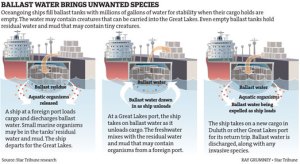Hemimysis anomala
ORIGINS
Hemimysis are native to the Ponto-Caspian region, which is the same area that zebra mussels originate from.
DISPERSAL
Dispersal across Europe has been occurring for the past two decades.
The first documented movement to North America occurred simultaneously in Lake Michigan and Lake Ontario in 2006. They have expanded their range into eastern Lake Erie and Lake Huron. The only Great Lake that has not been invaded yet is Lake Superior.
HOW DID THEY GET HERE?
As with most invasive invertebrates, Hemimysis were introduced by ballast water transport. Due to the ability of Hemimysis to survive and reproduce in brackish waters (up to 18ppm), they are able to survive during transoceanic voyages in ship ballast tanks.
ADVANTAGEOUS CHARACTERISTICS
1. Flexibility in Habitat
– Found in brackish waters and able to flourish freshwater habitats
– Found in 10m near shore areas and up to 30m
– They are found in swarms near Harbours, where excellent rock and shade coverage are found. Below is a swarm of Hemimysis found in Montreal Harbour
2. Temperature Tolerance
– Broad range 0-30 Degrees Celsius
– Native Mysis diluviana can only survive up to 17 Degrees Celsius
3. Faster Life Cycle
– Can produce up to 4 generations per year
– Native Mysis diluviana can only produce 2 generations
4. Adaptive Feeding
– Can adapt feeding strategy based on environmental conditions and food availability
– Consume pelagic food sources in sheltered sites in Montreal Harbour
– Consume benthic food sources in exposed sites outside the Harbour
5. Predator Avoidance
Predators may consume Hemimysis if:
– They feed after dark, near shore, and up in the water column
– They can consume swiftly moving prey
– From a study by Lantry et al, 2009, out of 17 fish species sampled in Lake Ontario, only 3 fish species (Rockbass, Alewife, and Yellow Perch) were found to consume Hemimysis
What is troubling is that despite the incorporation of Hemimysis into the diet of these planktivorous fish, Hemimysis has not been stopped and continues to spread and become locally abundant.
SAMPLING RESULTS FROM THE FIELD
We set out 3 Hemimysis traps at four different locations. We left them overnight and collected them the next day to see if Hemimysis had spread from Lake Ontario into more inland lakes. Sampling of Kingston Marina last summer did not result in any Hemimysis being found. In contrast, this summer our 3 traps were able to collect 32 Hemimysis in total. The implications of this finding are that prevention strategies need to be established and put into place quickly so that the spread of this invasive species does not impact our more inland lakes.
MANAGEMENT STRATEGIES
One of the most effective strategies to limit the spread of Hemimysis is through emptying and decontaminating boat ballast water. Locks along the Rideau Canal need to ensure that boaters check their ballast water.
Various decontaminating methods can be applied to prevent the spread of invasive species in general.











